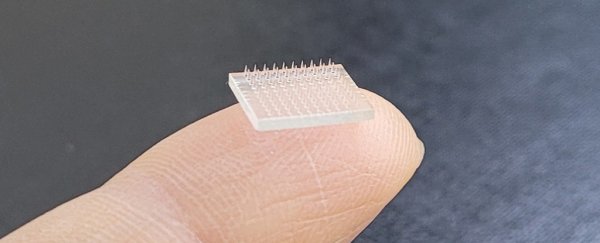Scientists have developed a microneedle 'vaccine patch' that promises a much greater immune response than traditional vaccine shots – and all without the potential pain and anxiety associated with conventional needles.
While microneedle patches have been in development for years, they have proved difficult to successfully manufacture at scale. What's more, it can be challenging to adapt the same patch for different types of vaccine.
This new research overcomes those problems with an advanced 3D-printing technique called continuous liquid interface production or CLIP, using ultraviolet light and a special resin to create the patches – patches that are consistent in size, shape, and needle spacing, no matter how many are made.
"Our approach allows us to directly 3D-print the microneedles, which gives us lots of design latitude for making the best microneedles from a performance and cost point-of-view," says microbiologist Shaomin Tian from the University of North Carolina at Chapel Hill.
The ease and speed with which these microneedle patches can be developed could bring them into much wider use, the researchers say. Besides avoiding conventional needles altogether, another advantage of these patches is that they can be self-administered – there's no need to book an appointment with a doctor or a nurse to get your shot.
This is because the short needles only have to penetrate just below the surface layer of the skin (transdermal), and not all the way through it (subcutaneous) like traditional vaccines.
The drugs get directly delivered in the vicinity of skin immune cells, which is perfect for vaccines. With a more efficient delivery system, it's possible that dosages can be lowered accordingly.
In lab tests in mice, the researchers found that their patch generated a T-cell and antigen-specific antibody response some 50 times greater than a traditional, subcutaneous injection delivered under the surface of the skin.
"Using model vaccine components, we demonstrated that 3D-printed microneedle delivery resulted in enhanced cargo retention in the skin, activation of immune cells, and more potent humoral and cellular immune responses as compared with traditional vaccination routes," the researchers explain in their paper.
The team says that its design and approach can be adapted to cover vaccines for flu, measles, hepatitis, and even COVID-19. There's no need for special handling or refrigeration in terms of transportation, which could help boost vaccination rates. The patches can even use recent improvements in the field to combine multiple drugs on the same patch.
While the patches have yet to be tested on humans, similar benefits should apply as have been seen in mice, enabling faster and more efficient vaccine responses to epidemics and pandemics in the future.
The researchers aren't standing still with their microneedle vaccine patch – next, they're looking at how RNA vaccines (including the Pfizer and Moderna COVID-19 vaccines) might be incorporated into this design.
"In developing this technology, we hope to set the foundation for even more rapid global development of vaccines, at lower doses, in a pain and anxiety-free manner," says chemical engineer Joseph DeSimone from Stanford University.
The research has been published in PNAS.
